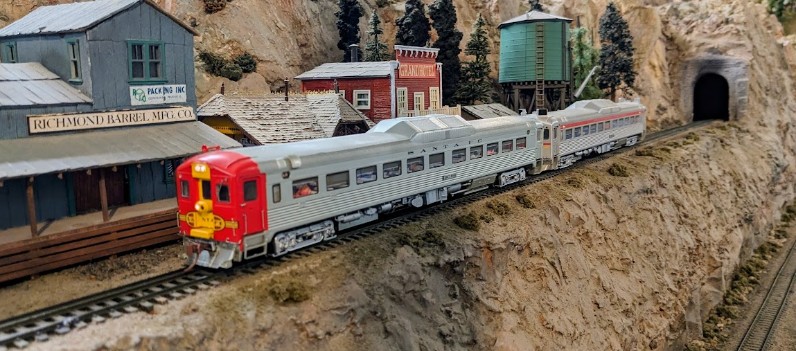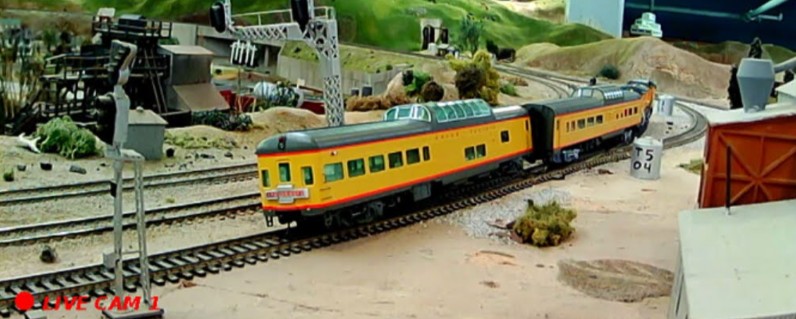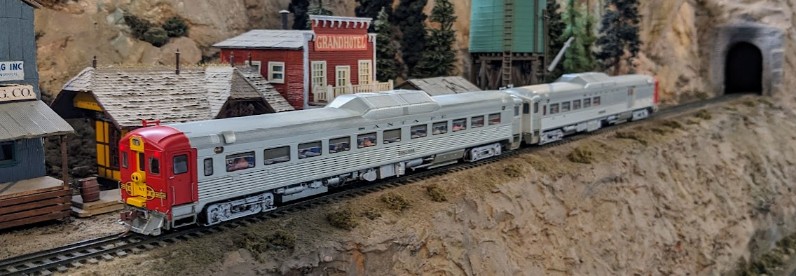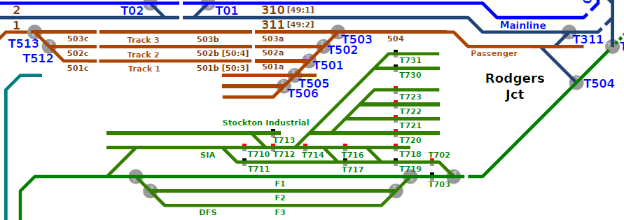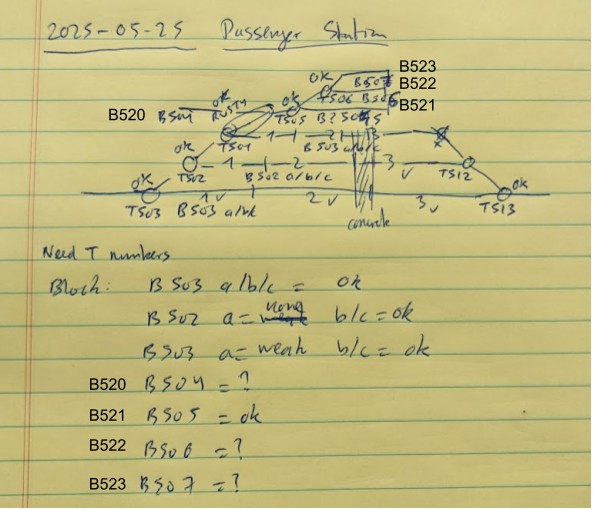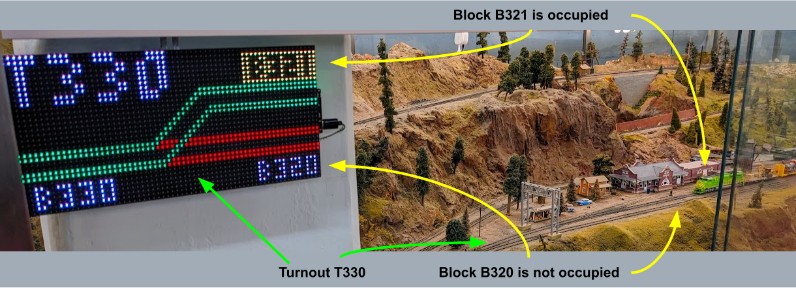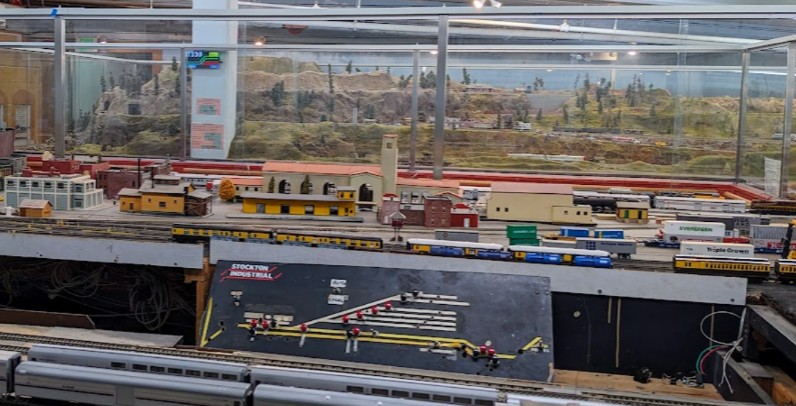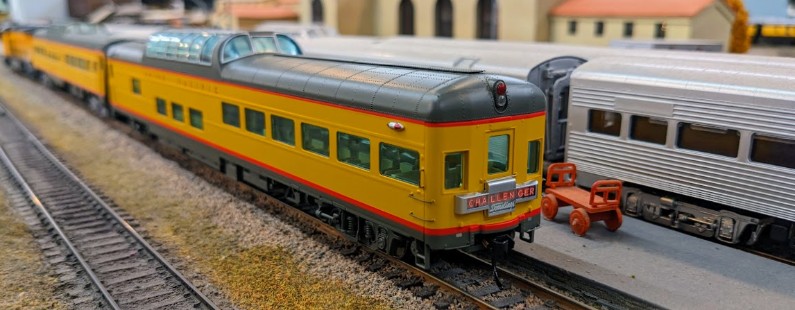The Randall Museum in San Francisco hosts a large HO-scale model model railroad. Created by the Golden Gate Model Railroad Club starting in 1961, the layout was donated to the Museum in 2015. Since then I have started automatizing trains running on the layout. I am also the model railroad maintainer. This blog describes various updates on the Randall project and I maintain a separate blog for all my electronics not directly related to Randall.
2025-07-27 - RDC Update
Category RandallSince only one of the two Santa Fe RDC engines currently runs satisfactorily, I’m currently running a little experiment with matching Santa Fe RDC 191 with the SP 10 RDC:
That combo works well. I checked and both engines are correctly speed matched. It’s certainly a non-prototypical setup though. I had previously run them together as an April’s Fools joke.
On the workbench, I got a new duplicate of the UP GE 9538:
UP 9538 has been diligently working the mainline since May and, although I initially had some reservations on the TCS decoder, I got it working quite satisfactorily. I decided to have an exact replica -- same engine number, same motor -- so that I can just trivially swap them every other month without having to reprogram the automation every time. That should help give the engine a much deserved break.
I also got a new UP SD40-2. This is an older Bachmann design with an Econami decoder. From experience, these work quite well. I’ve tested 3450 on the mainline, and it seems very adequate. I’ll program it in the automation soon, giving me one more engine to swap from time to time.
The Santa Fe RDC 191+192 that I put back in automation is giving me some issues. It just keeps stopping from time to time in the tunnel before YouBet or the tunnel to the branchline canyon. Then, much later, it seems to respond to DCC commands again yet at the point the automation’s recovery mechanism has already given up.
Today I went to see where it got stuck and I noticed that one of the two cars seems to have no power, and the other car is not powerful enough to drag both units -- that’s to be expected since I “downgraded” these engines from two to one motor per car, so they don’t have a lot of pulling power. Thus right now I’m just going to run this as a single car train and monitor how that works. I may want to upgrade both engines with a LokSound “Capacitor / KeepAlive” to see if that helps.
The UP Passenger has this nice UP Observation/dome car provided by Jim, which has recently started to derail:
It consistently derails when going in reverse on the same spot over the T311 turnout. That area is very hard to reach -- farther than arms’ length -- so I can’t just get close and look carefully at the wheels on the turnout. It does also derail when I run just that one car with the same engine:
One suggestion from Orion was to turn the truck around, so I’ll try that another time.
The older and more “primitive” dome car works well, so the UP passenger train is back to having a single car:
The Rapido Santa Fe RDC 191+192 is back on the Branchline automation:
What’s new about it? Well, last time, they both totally stopped working and I did a major overhaul of both engines:
- Replaced speakers,
- Replaced motors,
- Changed them to single-motor operation.
The original motors were known to become problematic. I contacted Rapido a while ago and they sent me new motors. Replacing the motors is a bit of a hassle as the RDC needs to be disassembled to the chassis.
These units have 2 motors, one per truck. With time, they tend to get out of sync and “fight” each other. Since the Branchline is mostly flat, the units are ok with running on just one motor. I simply disconnect the other motor and remove one gear in the trucks to make one truck free-rolling.
One thing both Orion and I would like is better usage of the SIA + DFS.
The SIA + DFS offers 6 tracks:
- The left most track for the Trolley… I’d like to reserve that one once I automate it again.
- 2 “mainline” tracks for the SIA.
- 3 “sidings” tracks for the DFS on the right.
These are the tracks in green on the schema / plan v8: Randall Map - Track Plan + Sensors 8.pdf
There are 2 separate issues here:
- Control of the turnouts.
- Power routing for the tracks.
Click here to continue reading...
I’ve quickly checked the Stockston Station tracks: which blocks have power, which turnouts work.
Turnouts:
- They all checked and worked “most fine”.
- T501 was a bit rusty but worked once moved a couple times. It has a mechanical oddity as it is offset and uses a wire to move the turnout.
- T513 is a common problem as Orion typically throws it to access Thomas and then fails to set it back to normal.
- All the turnouts seem to be Tortoise -- they were slow and did not make the characteristic Fulgurex sound. Needs to be verified visually.
Blocks:
- On the Perry schematics, I noticed that tracks are labeled T3/T2/T1 as expected (with T1 being the inner one), and the top tracks are labelled GT1/2/3 -- I’m guessing for “garage tracks”. I could keep them as blocks B504..B507, or it would be worth giving them a different range of numbers >= B520 (we’re using T51x for the turnouts at the end of the station) such as B520 up to B523. See drawing above.
- In this case, we would renumber the turnouts accordingly? Maybe not.
- Track B503 tested fine on all 3 segments.
- Track B502 a and B501 a would not light up the LED light. b & c worked.
- Garage track B521 tested ok, but garage tracks B520, B522, and B523 did not light up the LED light.
- They also seemed to slightly turn on the light even when off.
One issue is that I have “dead/DC” engines and cars on these tracks.
I should redo the testing without the static display equipment, and I should measure voltage at the panel. Also I have a perfectly valid RRAmpMeter that would be awesome for that which I’m not using -- what we really need is a test involving a light bulb to force current consumption.
Looking at Plan+Sensors v7, this is what I had planned in 2017: Randall Map - Sensors 6.pdf
Click here to continue reading...
I have installed my latest experiment at Randall: the Distant Signal project.
This displays the status of the turnout T330 to the Saturday Operators, using a LED Matrix Display.
The green and red lines show the state of the turnout: normal or thrown/divergent. “T330” is the number for the turnout being shown -- in this case the Sonora turnout, just in front of the train on the video above. The block numbers (B320, B321, and B330) reflect the track occupation as seen by JMRI -- the blocks are yellow when they are occupied.
The display is mounted in a way to be clearly visible for the Saturday Operators when they stand at the Stockton Yard -- that’s the location from which they operate their trains, and from this vantage point of view, it’s impossible to know how the turnout is aligned -- and that’s exactly what this new panel is supposed to clarify:
As explained in the first post about the Distant Signal project last month, the display connects to the main automation computer over wifi. Since it derives the state from JMRI and the NCE Command Station, the display is in sync with turnout changes whether they are initiated by the automation computer or by a user changing the turnout using a NCE controller.
For now, this is an early experiment. I expect changes based on usage feedback.
Eventually, if that’s well received, I would like to duplicate this effort to a few over turnouts which are either hard to view or impossible from the main Stockton Yard location: the Bridgeport turnout, and the mainline to Napa yard turnouts. The Bridgeport turnout is the first one where I added a LED indicator years ago to solve exactly that problem, and it can now benefit from a nicer display. The Napa yard turnout is on the other side of the mountain, and the only way to know its state is to actually walk over there. In this case I’d place a similar display in the Stockton Yard area so that it’s easy to know what’s going on the other side of the mountain.
Back in 1983, Santa Fe and Southern Pacific almost merged together. OK almost. Then the merger got surprisingly forbidden due to what honestly with hindsight looks like bad federal decision making as both companies failed and then got absorbed by BNSF and UP respectively (so instead of ending up with 3 major railroads in the west, we only ended up with 2!) But if they hadn’t, maybe we would have more SPSF engines with their sumptuous “kodachrome” color scheme today, and I’m imagining they would have combined their respective RDCs as such:
I recently finished overhauling the Rapido RDC SP-10 as well as the Rapido RDC ATSF 192/192: new speakers, new motor(s), a single running motor/truck per engine (the other one is idle), and more little people details in there. And they run surprisingly well together on the Branchline at the Randall Museum between the Angels Camp and the You Bet stations!
Obviously the entire thing is tongue-in-check / fiction. Happy April’s Fool Day! The automation doesn’t run the three RDCs together as shown above, or does it? Right now we have RDC SP-10 running, and later I may switch to the RDC ATSF pair as I had it in the past. We try to run stuff as prototypical as we can.
Courtesy of Jim, we have a new Walthers Proto dome car on the automated Mainline Passenger train:
The new dome car is at the end since it is also an “observation” car, with some nice details:
The car is a Walthers Proto, with body-mounted Kadee couplers, metal wheels, and it has a decent weight to it. After installing the car, I’ve tried the automation a handful of times and it seemed very stable. It’s a great addition to the fleet!
Recently the Mainline automation was back at using the good old Athearn UP 8736 engine. After the fiasco of the Walthers units, I’ve decided to try something different, so here we have the Mainline automation train pulled by this new Bachmann UP 9538:
Whilst I was at it, I’ve changed the Mainline Freight train to use SD70ACe 1072 instead of 1067. These are two Bachmann engines that have proven quite resilient and successful over the years. I recently cleaned 1072 and it’s running fine after a good cleanup of the wheel power pickup.
UP 9538 is a GE Dash 8-40CW, replacing the EMD SD70ACe. I chose these engines because they are both modern and highly recognizable.
UP 9538 is currently an experiment. I want to give them a few weeks to evaluate how well it behaves in automation. The engine uses a more modern TCS Wow Diesel, with a fairly capable “current keeper” capacitor as can be seen in this loco chassis image.
Click here to continue reading...
I just swapped the Rapido Amtrak 204 train on the Branchline, and reinstalled the good old Rapido RDC SP 10:
That little engine had been the workhorse of the automation, back in 2017 on the Mainline, and back in 2018 on the Branchline. It’s back again on the Branchline automation for a little while, to give some much needed rest to the Amtrak 204 engine.
The RDC SP 10 is a Rapido engine, and I gave it a pretty decent overhaul back in 2023.
The speaker was dead and got replaced. I originally replaced it with a 3rd party similar speaker I found (it’s an iPhone 4 loudspeaker style), and then later got the proper part from Rapido’s excellent maintenance support team.
The two motors were both in bad shape, not running well, and very much out of sync and no longer speed matched -- which is a common occurrence on these Rapido RDC units.
After I got new motors from Rapido, I proceeded to install the new motors, which is no small task. Except what I did is install only one motor. Since the engine now has only one motor, it’s a bit weaker and can’t make it up the grades on the layout; however the Branchline has only a very very small grade so it’s not a problem. On the other hand, there isn’t a second motor to get out of sync and fight with the first one, and it means I have a replacement if and when I need one more motor swap.
The decoder, besides being an ESU LokSound (they don’t really seem resilient in the long term), is doing reasonably well on these units. In this case, it has only one small residual issue which is that sometimes the engine stops responding to sound-off commands until it is power-cycled -- which will happen at the end of the day anyway when the museum staff turns off the layout.
The only issue remaining is that the RDC SP 10 derails on the new Branchline turnout replaced by Orion. Consequently, I changed the automation to have the engine stop at the station before the turnout. That means that I can’t program it to clear the branchline and allow a train to divert from the mainline to the branchline.
